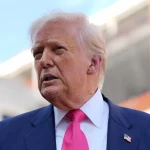
–>
November 9, 2022
Organizations like #NeverAgain, founded by students of the Marjorie Stoneman Douglas High School shooting in Parkland, Fla., assert that America’s school shooting epidemic has indelibly marked Gen Z the generation of mass shootings. The organization’s success is impressive. One of its founders was not on Twitter before the shooting but eleven days later had more followers than the NRA (est. 1871), and since its inception (2018), the organization’s annual student protest (video), “National School Walkout,” has exceeded expectations.
‘); googletag.cmd.push(function () { googletag.display(‘div-gpt-ad-1609268089992-0’); }); }
In 2018, Time reported that #NeverAgain raised more than $4 million on GoFundMe, “plus a couple million more from … George and Amal Clooney, Steven Spielberg and Oprah Winfrey.” A top Hollywood P.R. firm offered services pro bono, Michael Bloomberg’s Everytown for Gun Safety contributed more than $1 million in grants, and mega-donor Tom Steyer donated $1 million to increase student voter registration, while The Brady Campaign to Prevent Gun Violence, Dream Defenders (a racial justice group formed around the Trayvon Martin incident), and Peace Warriors (a Chicago anti-violence group) joined efforts as well. Even corporate media rolled out the red carpet.
CNN’s 2018 town hall featured #NeverAgain founders and other survivors of the Stoneman Douglas shooting pitted against NRA spokespersons, Florida law enforcement, and politicians on both sides of the issue. Tensions flared when parents like Fred Guttenberg squared off with Senator Marco Rubio: “My [14-year-old] daughter … was shot in the back … with an assault weapon, the weapon of choice. … It’s a weapon of war.” Although it’s not the weapon of choice (handguns are used in 75% of shootings) or a weapon of war (smaller caliber and semi, not fully, automatic) Florida congressman Ted Deutch echoed parents’ angst: “150 rounds in 7 or 8 minutes … weapons of war that serve no purpose other than killing the maximum number of people” should be banned.
Rubio replied, “Virtually every rifle sold in America today can do what that gun does,” intimating that such a ban would ban all rifles. However, he assured the audience that he and Senator Bill Nelson were spearheading the Fix NICS Act, which may infringe upon privacy rights if access to psychiatric medical information, precluded under HIPAA, is deemed necessary. Rubio also championed Florida’s red flag laws, termed by some a backdoor to gun control. Nineteen states have them.
‘); googletag.cmd.push(function () { googletag.display(‘div-gpt-ad-1609270365559-0’); }); }
Legitimizing the idea that mass shootings are an epidemic in America, Deutch referred to 3,300 high school teachers and/or students and families as “survivors” — consistent with methodologies used by news outlets like the Washington Post (WaPo) that essentially equate victims of gun violence with the number of students enrolled where a shooting occurred. This enables the WaPo to report that “320k students have experienced gun violence at schools since Columbine” when the actual number is closer to 3.6K. It would be like claiming that all Americans are survivors of the Revolutionary War when only ten percent were involved. To redefine “survivor” in this way would require that most of history be rewritten. All in all, CNN’s town hall showcased gut-wrenching anguish felt by victims’ family, friends, teachers, etc. that likely moved many to tears. But do tears alone belong in America’s gun control debate?
Not once in two hours was the number of mass shootings (133 in 39 years, 3.5/yr) or students killed (1K, 28/yr) or injured (2.6K, 68/yr) relative to the number of children in America, 0.004%, mentioned. Nor were the odds of being shot in a mass shooting (1 in 11K), 1,571 times less than dying from cancer (1 in 7), presented. No one stated how often so-called “assault rifles” (10% of the time) are used or how many shootings are stopped by armed civilians (49% in 2021). Nor were gun-free zones, Israeli policy, or the effects of drug use and nihilistic ideologies (that deny God’s existence) on the mental state of shooters discussed. Perhaps most remarkably, no one mentioned that all public policy is legally constrained by the U.S. Constitution.
Although many on stage were paid to uphold the Constitution and most in the audience were U.S. citizens, the social compact that binds all Americans together was met not with praise, but with challenges as to the 2nd Amendment’s meaning of the word militia and whether the founders envisioned weapons beyond muskets — intimating that semi-automatic weapons (85% of handguns manufactured in 2018) are constitutionally out of bounds. Instead, the pain of survivors and what that pain demanded were most on display. In response, politicians added insult to injury by vowing to infringe upon yet more rights without deference to tragedies that have followed national firearm bans as night follows day — for if students gunned down by an evil and deranged person is a horror beyond words, what are tens of millions slaughtered by an evil and deranged government?
Public policy operates along a continuum between governmental control and individual freedom, with real consequences that affect real people. Sound public policy in America, where individual freedom is foremost — borne out in lives lost securing and defending it — must answer questions like “what’s the tradeoff between benefit to some and cost to all?” and “what’s the impact on individual freedom within the context of the U.S. Constitution?”
The 2nd Amendment was bequeathed not out of paranoia over 18th-century monarchical abuse (as if the innate tendency of the powerful to oppress the powerless has an expiration date), but as a timeless check on governmental overreach. In that context, the founders’ prescience regarding semi-automatic weapons is irrelevant. The founders understood a simple law of nature: imbalances in power invite exploitation. From this vantage point, whether victim and criminal or militia and government, parity is required to avoid violence. Firearm bans create disparity, emboldening criminal exploitation. That’s why nations without guns like the U.K., Sweden, and Germany have more total crime than the U.S.
Ask yourself this: if America with guns has less total crime than nations without guns, then how are guns the cause for violence? So, when students at #NeverAgain rallies hold signs that read, “Protect students not guns,” they unwisely pit themselves not against guns, but against victims and the cornerstone tenet of this nation: freedom.
‘); googletag.cmd.push(function () { googletag.display(‘div-gpt-ad-1609268078422-0’); }); } if (publir_show_ads) { document.write(“
No one debates a pain beyond comprehension. What’s debated is whether the evidence supports the proposed change. Those affected cry “yes.” Who would expect them to “cry” otherwise? But public policy doesn’t affect only those directly involved; it affects all citizens, and as such, it requires a broadening of both the fact set and perspective.
The CNN town hall was not a requiem Mass to honor those mercilessly and brutally killed. It was an emotional plea designed to gnaw at the consciences of concerned parents and instill fear in the hearts of students to challenge a freedom so essential that the founders declared a free nation impossible without it. And yet, it’s phenomenally effective: nearly 50% of Americans today irrationally fear mass shootings — a threat 1,600 times less likely than cancer — to the point they’re willing to forgo the cornerstone tenet of this nation to avoid them.
Has ours become a time when irrational emotion supplants rational evidence, feelings overthrow facts, and personal scruples supersede principle, or is there still room for more than tears in America’s gun control debate?

Image via Pxhere.
<!– if(page_width_onload <= 479) { document.write("
“); googletag.cmd.push(function() { googletag.display(‘div-gpt-ad-1345489840937-4’); }); } –> If you experience technical problems, please write to helpdesk@americanthinker.com
FOLLOW US ON
<!–
–>
<!– _qoptions={ qacct:”p-9bKF-NgTuSFM6″ }; ![]() –> <!—-> <!– var addthis_share = { email_template: “new_template” } –>
–> <!—-> <!– var addthis_share = { email_template: “new_template” } –>




